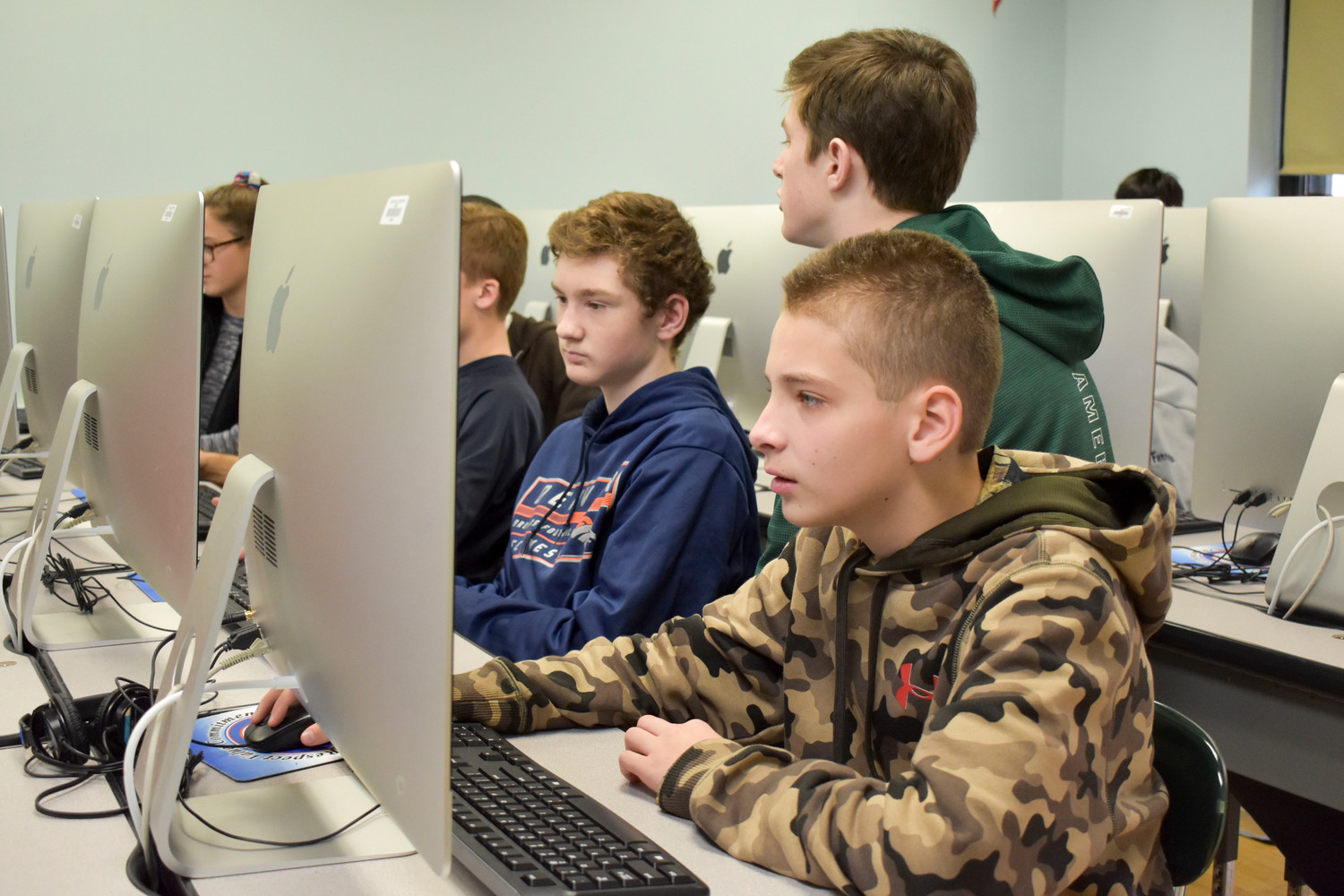South Side High School's new coding course is a virtual playground
Students explore coding in South Side’s new elective
“Say if I type in . . . ‘Honey, where’s my super suit?’” freshman Christian DiRubbio said, referring to words hollered by Lucius Best in Pixar Animation Studios’ “The Incredibles” as he searches for the outfit he dons to turn into superhero Frozone.
The ninth-grader used his keyboard in South Side High School’s STEAM Lab to enter the words into a question bot, which the students programmed to answer specific inquiries as part of the school’s new coding course.
“It’ll answer, ‘I put it away,’” Christian said with a smile — just as the superhero’s wife responded in the film.
The half-year elective, taken by students in grades nine through 12, was created in response to student interest, according to Principal John Murphy, as well as from input from graduates who said the class would have benefited them. The coding course is held in the school’s new science, technology, engineering, art and math lab, featuring 20 computers and a SmartBoard, which was assembled with existing school resources.
“The increase in the prevalence of digital technology in our art classes, specifically HTML, and web design and digital graphics, lent itself to what we’re now calling computational problem-solving,” Murphy added. “Coding does that. It’s that logically coherent linear algorithmic thought that we were really trying to impart.”
The growth of South Side’s robotics club, he also noted, which involves coding, gave the district another reason to offer the course. “It was the confluence of those three things that really accelerated our search for an answer,” Murphy said.
Keith Gamache, an art teacher in the district for 24 years, offered to teach the course. His only prior experience in the subject matter, he said, came in the late 1980s, when he learned how to code basic language on an Apple IIe in high school. Gamache took a series of professional development sessions in preparation for teaching the course, he added, and continues to learn the skill with his students.
“Six months ago, when I looked at a page of code, I saw numbers and letters on a screen, and it was completely intimidating,” he said. “I think one of the goals for this class is to at least get the kids to look at code, and not just be intimidated by a bunch of numbers.”
The course uses Xcode, an application containing development tools made by Apple for creating software. It supports code for a variety of programming languages, including Swift, which South Side students are learning.
“[Students] have the ability to look at things now,” Gamache explained, “and even if they won’t be able to tell you how it runs, they’ll be able to tell you, ‘That’s a string, this is manipulating characters here, this is working with numbers, this is a function.’”
Like several other coding students, sophomore Drew Downing pointed to creating the question bot as one of his favorite parts of the course. “We get to show what we learned,” he said, “and we got to actually make something, which was pretty fun.
“If we finish early, we get to experiment,” he added, noting that he developed a rock-paper-scissors game.
After Gamache offered a brief introduction to the new lesson during a class taught earlier this month, the students were encouraged to do exercises on their own. The class is more like a lab than teacher-led instruction, Murphy explained, and because of that format, students can take it more than once.
“It’s out of the ordinary, and I guess it teaches you stuff within the computer and shows you how everything works,” 10th-grader Alexis Duhaney said. “I can appreciate how much work goes into each program and the depth of computers and programming.”
Some students expressed an interest in a career involving computer programming. Others, such as senior Stephanie Masotti, simply thought coding was a good skill to learn.
“I thought it had to do with math, and I’m realizing it doesn’t, really, but it’s still pretty cool,” Masotti said, noting that she plans to study math or art in college. “It gets really tough; I’m not going to lie. Coding is very hard and I get frustrated, but it’s rewarding.”
The students made apps earlier in the semester, which displayed images of some sort. As Gamache walked around the room, he told DiRubbio about a more complex idea for an app that he had discussed with an art student.
His vision was a “Secret Santa” app that would randomize the names of participants, and give each user the ability to insert qualities they like in a gift.
“And then a price range,” DiRubbio interjected excitedly.
“And then it automatically goes to Amazon and shops,” Gamache shot back. “You could even push it all the way that you make an app that orders and buys it for you . . . and then a drone flies and delivers it to the place.”
“Amazon is using drones now,” DiRubbio said.
In addition to thinking outside the box, students are using code in different ways to complete the same tasks, Gamache said, which teaches them that there are multiple solutions to problems. “One kid went to use a double ampersand to link those two statements,” he explained, “and the other kid said, ‘I did it just by putting a comma in between them,’ and both of them worked.”
Efficiency is the next step, he added. The possibility of creating a next-level coding course, Murphy said, is being discussed.
“Coding is now, in our generation, high in demand, and it’s going to be a really needed job in the future,” junior Samantha Schaeffler said. “A lot of things in our society rely on apps and stuff, so I feel like it’s going to be very useful.”










